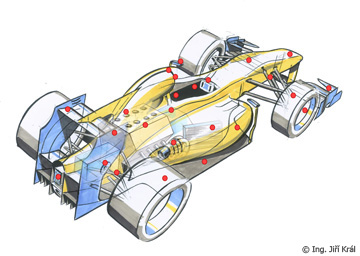Informace týmu HAAS F1
Mike Arning/HAAS F1 | 8.5.17 | Aktuality
HAAS F1 2017
Barcelona Base Camp
Climb Up Formula One Mountain Begins at Barcelona with
Spanish Grand Prix Serving as Early-Season Acclimatization
KANNAPOLIS, North Carolina (May 7, 2017) – Formula One’s mountain of competitiveness is incredibly steep, and ascending it is both arduous and exhilarating. For Haas F1 Team, which is in its sophomore season contesting the FIA Formula One World Championship, Circuit de Barcelona – Catalunya has served as its base camp.
The 4.655-kilometer (2.892-mile), 16-turn circuit is the home of winter testing for all Formula One teams, where for two weeks in late February and early March, organizations unveil their new racecars in the flesh and then run as many laps as possible in the pursuit of aerodynamic balance, mechanical grip and speed.
As the most recent Formula One team and the first American outfit since 1986, Haas F1 Team has only two winter tests at Barcelona. They have proven incredibly valuable, with the team shaking down its very first racecar last year – the Haas VF-16 – and then another drastically new racecar this year in the Haas VF-17, which was built under a new set of technical regulations that included a wider front wing, larger barge boards, a lower and wider rear wing and a diffuser that expanded 50 millimeters (two inches) in height and width. Wider tires from Pirelli supplemented these changes, with 60-millimeter tires up front and 80 millimeter tires in the rear, a 25-percent increase from 2016.
Haas F1 Team logged 715 laps in this year’s winter test at Barcelona with drivers Romain Grosjean and Kevin Magnussen collectively accumulating 3,328.325 kilometers (2,068.125 miles). The mileage total was a clear indication of Haas F1 Team’s growth since its inaugural season in 2016, as it shattered the mark set a year prior by 241 laps or 1,121.855 kilometers (697.088 miles).
“You could really see a difference from last year when we had our first winter test,” Grosjean said. “The team was much more ready. Everyone knew what they had to do. And the car has a lot of potential, which we haven’t unlocked yet. It’s a good baseline.”
The potential Grosjean refers to was seen in his sixth-place qualifying effort in the season-opening Australian Grand Prix and points-scoring finishes by Magnussen in China and Grosjean in Bahrain.
But after four races at four drastically different racetracks in four exceptionally different environments, it’s time for potential to turn into reality. That comes May 14 in the Spanish Grand Prix, where teams return to Barcelona for the fifth race of the Formula One season.
If finding success in Formula One is akin to climbing Mount Everest, then the Spanish Grand Prix serves as one’s acclimatization climb. A 66-lap race on Sunday preceded by two 90-minute practice sessions on Friday and a final hour-long practice on Saturday before knockout qualifying that afternoon allows teams to gauge its performance to fellow squads and also itself.
What kinds of improvements have been made since those cool, crisp days of late winter? And what updates will you unveil to ensure your car remains competitive for 16 more races? Those are the questions teams try to answer in the Spanish Grand Prix, where the competitive arms race of technological bits and pieces are debuted by teams up and down the pit lane.
Haas F1 Team is no different, bringing a significant upgrade to its VF-17, the details of which are being kept close to its vest. But Grosjean and Magnussen are fully aware of these upgrades and how the data says it should help unlock the potential both drivers feel is innately built into the car while simultaneously advancing its overall competitiveness.
Its performance, as well as the exploits of the nine other teams around them, will be on full display in the Spanish Grand Prix.




